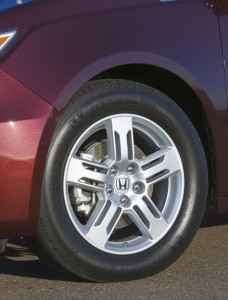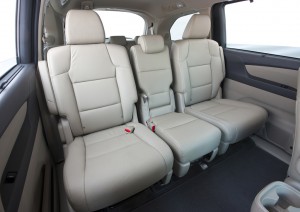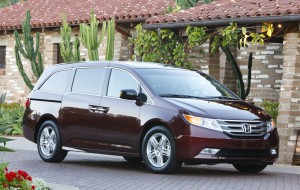
The 2011 Honda Odyssey features an interesting "lightning bolt" design that improves the view for third-row passengers
The minivan wars are on. All of the major players are either making major updates to their boxes or introducing completely new models. The timing could be a good right to push minivans. With the possibility of rising fuel prices on the horizon, many car buyers will be looking for better efficiency. But they still need the space to carry a junior hockey team, not to mention their gear. They still need to be able to fold down the seats and help a teenager move up to college. They still need to bring home a new couch.
Love them or hate them, minivans offer the most space for the least money with the best fuel mileage and handling of any vehicle type on the planet. Period.
While the minivan market may never again be what it was at its peak in the ‘90s, it could be poised for a comeback. Honda expects the market to grow by 13 percent between 2009 and 2012. The minivan leaders – Toyota, Chrysler, Honda and even Nissan – have all introduced stylish new vans, or made significant updates, that might make some of the naysayers actually consider them again. So into this market, Honda has rolled out the latest version of its Odyssey minivan. The Odyssey has always been the driver’s minivan and that doesn’t change with the latest version. While there’s no hiding the fact that this box weighs 4,560 pounds, it steers and handles like something somewhat smaller. While Nissan and Toyota have gone overboard trying to make their boxes ultra stylish, the Honda is more conservative. The look is somewhat controversial, mainly because of what Honda is calling the “lightning bolt” belt line design. The bolt presents a unique styling element on the outside, but it also improves visibility for third-row passengers on the inside. Inside, Honda has made the seats easier to use. Access to the third row is easier. And, while Honda has always called its third-row seats the Magic Seat, this latest version really is magic. Pull one strap and the seat folds itself into the well – usually. Sometimes it didn’t work exactly as advertised, requiring one additional tug on a second strap. Still, it’s far easier to use than the third-row seats in Chrysler’s minivans, for example.
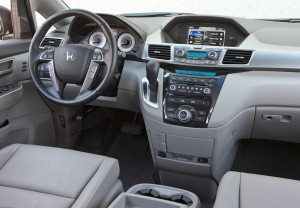
The Odyssey's instrument panel features metal-look trim rings inside the gauges that matches the trim on the dashboard.
To maximize space in the Honda, the middle-row seats have to be removed and stored outside the vehicle. That would seem to be a disadvantage compared to Chrysler’s second-row Stow ‘n’ Go seats, but the Honda’s seats are spaced further apart, meaning there’s room for another seat inbetween the outer seats. All of the leather-covered seats in this Odyssey Touring were comfortable. Even the third row is inhabitable by adults – try that in a crossover or SUV – although the cushion is a little too low. Since headroom is still expansive, Honda could have raised the cushion for adults. Oh well, more Nintendo-playing tots will be spending time back there than folks with Blackberries.
As is typical across autodom these days, the Odyssey features a sculpted and stylish dashboard. The silver rings inside the gauges is matched to the silver on the dash. The center console is bulged out, bringing the buttons for the stereo, climate control and navigation closer. As in the past, the Odyssey remains the driver’s minivan. While the steering doesn’t have quite enough heft, it’s accurate and easy to place the van where you need it. It handles curves well, yet the ride is divinely smooth. In fact, smooth describes the entire driving experience. It all starts with Honda’s well-known 3.5-liter V-6, which is as smooth as a Cool Whip. Making 248 horsepower, Honda’s mill gives up xx horsepower to Chrysler’s new 3.7-liter V-6, but it still has plenty of power to efffortlessly merge into traffic. A bonus is class-leading highway fuel mileage of 28 mpg in Touring and Touring elite models. City mileage is 19.
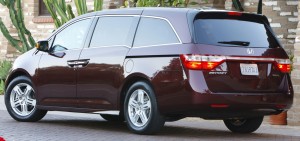
They Odyssey's split third-row seats fold more easily into the rear wheel than the previous edition.
The Honda uses cylinder deactivation to maximize fuel mileage when power requirements are light. The only way you’ll ever notice is by watching for the green ECO light on the instrument panel. In the Touring Elite tested here, that engine is connected to a slick-shifting 6-speed automatic transmission. Unfortunately, there’s no manumatic function, just a button on the side of the shifter that shifts the transmission to fourth gear, oddly enough. LX, EX and EX-L trim levels make due with a 5-speed automatic. The biggest difference between the transmissions is fuel economy ratings. Five-speed models are rated at 18/27. The gearshift is too easy to pull past D and into L, partly because the PRNDL doesn’t light up next to the lever. Look between the gauges on the instrument panel to see what gear the transmission is in. 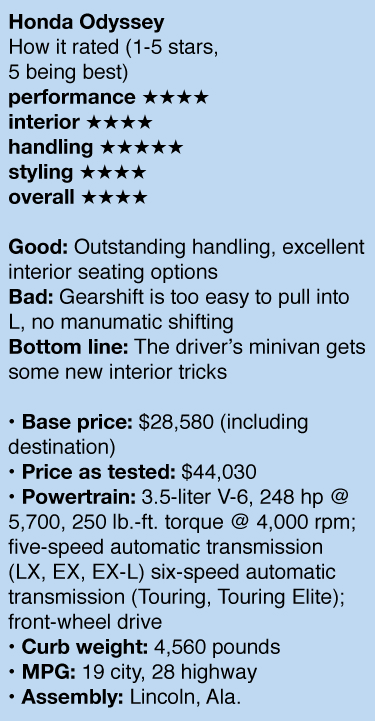 And there’s that strange “lightning bolt” styling element. Well, some buyers might like it, so that could be viewed as a positive. There was a time when every automaker other than Chrysler had trouble figuring out the minivan formula. Some made bizarre-looking egg-like vehicles with engine actually placed under the front seat. Others were too small. For years, Ford and GM refused to invest in front-wheel-drive platforms for their minivans. Now, all of the remaining players have figured it out. While they all do it a little differently, they all have V-6s driving the front wheels, they’re all in the neighborhood of 202-205 inches long and they all have 60/40 split disappearing third-row seats. It comes down to details, styling preferences. If you want third-row seats that simply fold, not tumble into the well in back, look at the Nissan. The Chrysler is the moving van of the bunch and the buckets to stow the seats can be used for storage when the seats are up. The Toyota’s interior is similar to the Honda, but the driving experience is a little softer. If you want a little sharper driving dynamics and you’re not put off by the lightning bolt, consider the Honda.
And there’s that strange “lightning bolt” styling element. Well, some buyers might like it, so that could be viewed as a positive. There was a time when every automaker other than Chrysler had trouble figuring out the minivan formula. Some made bizarre-looking egg-like vehicles with engine actually placed under the front seat. Others were too small. For years, Ford and GM refused to invest in front-wheel-drive platforms for their minivans. Now, all of the remaining players have figured it out. While they all do it a little differently, they all have V-6s driving the front wheels, they’re all in the neighborhood of 202-205 inches long and they all have 60/40 split disappearing third-row seats. It comes down to details, styling preferences. If you want third-row seats that simply fold, not tumble into the well in back, look at the Nissan. The Chrysler is the moving van of the bunch and the buckets to stow the seats can be used for storage when the seats are up. The Toyota’s interior is similar to the Honda, but the driving experience is a little softer. If you want a little sharper driving dynamics and you’re not put off by the lightning bolt, consider the Honda.


